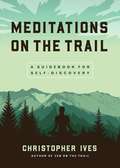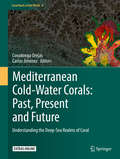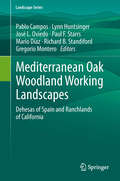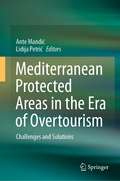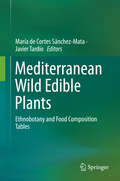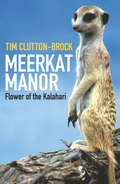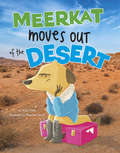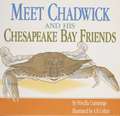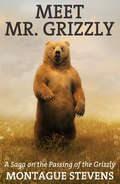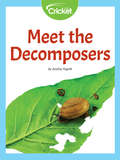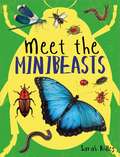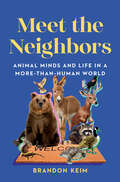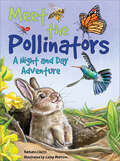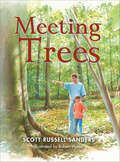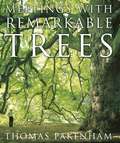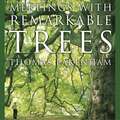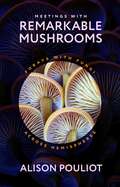- Table View
- List View
Meditations on the Trail: A Guidebook for Self-Discovery
by Christopher IvesDiscover how to explore and deepen your connection to nature with a rich array of do-anywhere meditations.Meditations on the Trail offers a rich array of do-anywhere meditations that will help you explore and deepen your connection to nature, and yourself, in new ways, making the most of your time on the trail. This small book—perfect for throwing in a daypack or a back pocket as you head out for the trail—is filled with practices to take you into the heart of the natural world and uncover your most vibrant self. You&’ll return home grateful, more aware of interconnection, and maybe just a little wiser. &“For walkers of all paces and geographies, this lovely book is a helpful guide for savoring moments on the trail, and feeling how deeply related we are to all existence.&”—Stephanie Kaza, author of Conversations with Trees: An Intimate Ecology
Mediterranean Cold-Water Corals: Understanding the Deep-Sea Realms of Coral (Coral Reefs of the World #9)
by Covadonga Orejas Carlos JiménezWhat do we know about Mediterranean Cold (Deep)-Water coral ecosystems? In this book, specialists offer answers and insights with a series of chapters and short papers about the paleoecology, biology, physiology and ecology of the corals and other organisms that comprise these ecosystems. Structured on a temporal axis—Past, Present and Future—the reviews and selected study cases cover the cold and deep coral habitats known to date in the Mediterranean Basin. This book illustrates and explains the deep Mediterranean coral habitats that might have originated similar thriving ecosystems in today’s Atlantic Ocean.
Mediterranean Oak Woodland Working Landscapes
by Gregorio Montero Jose Luis Oviedo Pro Lynn Huntsinger Mario Diaz Pablo Campos Paul F Starrs Richard B StandifordThe oak tree was a boon companion as humans expanded their presence across much of the globe. While oak woodlands (Quercus spp.) come today in stunningly diverse forms, the stately dehesas of Spain and the dramatic oak-dominated ranchlands of California are working landscapes where cultivation and manipulation for a couple of millennia have shaped Mediterranean-type ecosystems into a profoundly modified yet productive environment that is sought-after by every manner of species. The grazing of wildlife and livestock in oak woodlands yields a remarkable plant and animal biodiversity, creating a mosaic of habitats and visually pleasing savannas. Added products unique to Spain such as Iberian pigs and cork, and in California multiple landowner benefits, include valued ecosystem services that allow owners, visitors, and conservation supporters to experience the benefits of woodland life. With its 15 chapters a decade in the making, this handsomely illustrated book covers key topics in oak woodland policy, ecology, and management in Spain and California, presenting new research results and reviewing an existing expert literature.
Mediterranean Protected Areas in the Era of Overtourism: Challenges and Solutions
by Ante Mandić Lidija PetrićThis book comprises studies that reflect on various influences of excessive tourism development in protected areas, and solutions designed and initiated to mitigate such challenges. A large proportion of tourism in Mediterranean destinations constitutes nature-based tourism, in particular, tourism in parks and protected areas. As a destination experiences higher intensity and density of tourism, the potential conflict between maintaining a healthy natural environment and economic development also increases. This has urged planners and decision-makers to devise and adopt innovative approaches that seek to strike a balance between tourism development and nature conservation. This book demonstrates the importance of collaboration across and beyond disciplines and of all groups of stakeholders for maximization of societal impacts and tourism-related benefits.
Mediterranean Wild Edible Plants
by María de Cortes Sánchez-Mata Javier TardíoThis book is the result of collaboration between botanists and food chemists, with the purpose of improving the knowledge of the main wild species of traditional use as foods in the Mediterranean area, focus on ethnobotanical aspects, natural production, uses and nutritional aspects. One of the novelties of the book would be the publication of complete food composition tables of at least 50 species, which are not usually included in nutrient databases of foods. Many of the data included would come from the chemical analysis of representative samples of these species and other would be compiled from the scientific literature. Since this topic has not been fully studied, this book would provide an interesting tool to be used with the purpose of the revalorization of wild food species, preservation of their traditional uses, and also as alternatives to improve the diversity of modern Mediterranean diets.
Meerkat Manor: Flower Of The Kalahari
by Tim Clutton-BrockThe life of the Meerkats - from the highly successful TV series, and soon to be released major feature filmMEERKAT MANOR is the true-life story of Flower, the heroine of the successful television series, and the dominant female of Whiskers group. Through words and superb photographs, the reader becomes closely involved in the life-or-death struggles, just like a soap opera, of this curiously attractive tribe. MEERKAT MANOR not only describes what meerkats do, but explains why they do it, providing important insights into the working of other animal societies, including humans.'They look cute and their teamwork has led some to suggest they are ideal role models for humans, but ... if MEERKAT MANOR is billed as a soap opera, it is one scripted by Quentin Tarantino' Mail on Sunday.
Meerkat Manor: Flower Of The Kalahari
by Tim Clutton-BrockThe life of the Meerkats - from the highly successful TV series, and soon to be released major feature filmMEERKAT MANOR is the true-life story of Flower, the heroine of the successful television series, and the dominant female of Whiskers group. Through words and superb photographs, the reader becomes closely involved in the life-or-death struggles, just like a soap opera, of this curiously attractive tribe. MEERKAT MANOR not only describes what meerkats do, but explains why they do it, providing important insights into the working of other animal societies, including humans.'They look cute and their teamwork has led some to suggest they are ideal role models for humans, but ... if MEERKAT MANOR is billed as a soap opera, it is one scripted by Quentin Tarantino' Mail on Sunday.
Meerkat Moves Out of the Desert (Habitat Hunter)
by Nikki PottsMeerkat is bored with its habitat! Follow Meerkat as it tries out different places to live. Which habitat will make the best home for Meerkat?
Meerkats (Nature's Children Ser.)
by Tim HarrisWhere do meerkats live? What do meerkats eat? How big are meerkats? Find out the answers to these questions and learn all about the physical characteristics, behavior, and habitats of meerkats.
Meet Chadwick and His Chesapeake Bay Friends
by Priscilla CummingsChadwick has many friends in Chesapeake Bay from an oyster to a seagull, a heron and many more.
Meet Mr. Grizzly: A Saga on the Passing of the Grizzly
by Montague StevensMeet Mr. Grizzly, first published in 1943, is the memoir of Montague Stevens – a Cambridge-educated Englishman who was a cattle-rancher in New Mexico, and who had a passion for hunting grizzly bears (with the help of his hunting dogs). The book chronicles some of his many adventures of hunting, dog- and horse-training, and on the natural history of the region. Included are 15 pages of illustrations.
Meet the Candidates 2020: A Voter's Guide (Meet the Candidates 2020)
by Scott Dworkin Grant SternGet informed about the campaign issues and policies of Democratic candidate Elizabeth Warren, the populist, progressive, definitively capitalist senator from Massachusetts.Meet the Candidates 2020: Elizabeth Warren: A Voter’s Guide will help you decide quickly if Warren deserves your vote for the Democratic nomination and to take on Donald Trump for president of the United States. Warren’s strong economic background sets her apart; the senator from Massachusetts defines herself as a capitalist first and seeks to make capitalism more equitable for all. She has already proposed sweeping anti-corruption reforms, refused PAC donations to her campaign, rolled out plans for college debt forgiveness and a tax on the super wealthy. Her background as a Harvard economist, author of TheTwo-Income Trap, and experience as an economic advisor to Barack Obama positions her well to make change happen. Warren’s campaign also features popular Democratic talking points—rebuilding the middle class, ending corruption in Washington, making voting laws more democratic, bringing our troops home and stopping endless war—but it’s her experience that sets her apart. From working the campaign trial for Hillary Clinton to weathering President Trump’s refrain of “Pocahontas” in reference to her claimed Native American heritage, Meet the Candidates 2020: Elizabeth Warren: A Voter’s Guide is your complete handbook to Elizabeth Warren’s resumé, campaign, and what America would look like if she won the presidency in 2020.The Meet the Candidates 2020 series is the informed voter’s guide to making a decision in the 2020 Democratic primary and presidential election. Each book gives an unbiased, political insider’s analysis of each contender, featuring: candidate interviews; an introduction by campaign advisor, Democratic Coalition co-founder, and Dworkin Report host Scott Dworkin; and compilation and writing by Occupy Democrats Editor at Large Grant Stern. In two hours of reading, you’ll understand their defining characteristics, credentials, campaign issues, challenges, presidential chances, and everything else you need to know to decide who should challenge Donald Trump. Whether it’s for Elizabeth Warren, Joe Biden, Bernie Sanders, Kamala Harris, Julian Castro, Cory Booker, or another, Meet the Candidates is what you need to make an informed vote for president in 2020.
Meet the Candidates 2020: A Voter's Guide (Meet the Candidates 2020)
by Scott Dworkin Grant SternWhat is “democratic socialism?" Educate yourself on Bernie Sanders, the liberal independent from Vermont and the 2016 underdog turned 2020 Democratic favorite. Bernie Sanders shocked the establishment in 2016 with his self-described “political revolution,” mobilizing grassroots fundraising and campaigning to nearly secure the Democratic nomination over Hillary Clinton (even in the face of Democratic National Convention opposition). The Vermont senator and longest-serving independent in congressional history hopes to do the same with a better result in 2020. Meet the Candidates 2020: Bernie Sanders: A Voter’s Guide will help you decide if Sanders’s brand of democratic socialism is for you and if he is the right candidate to take on Donald Trump.A vocal critic of Donald Trump, Sanders advocates for sweeping reform: single-payer, universal health care, labor and economic inequality reform, taxes on the wealthy, the Green New Deal, marijuana legalization, free higher education. Sanders has had an undeniable influence on how campaigns are run and has moved the Democratic party to the left, but how will his liberal platforms play in a Democratic primary and against Trump in a general election? After reading Meet the Candidates 2020: Bernie Sanders: A Voter’s Guide you’ll be able to analyze those chances, explain his positions, and decide if they are what you believe is right for America. The Meet the Candidates 2020 series is the informed voter’s guide to making a decision in the 2020 Democratic primary and presidential election. Each book gives an unbiased, political insider’s analysis of each contender, featuring: candidate interviews; an introduction by campaign advisor, Democratic Coalition co-founder, and Dworkin Report host Scott Dworkin; and compilation and writing by Occupy Democrats Editor at Large Grant Stern. In two hours of reading, you’ll understand their defining characteristics, credentials, campaign issues, challenges, presidential chances, and everything else you need to know to decide who should challenge Donald Trump. Whether it’s for Elizabeth Warren, Joe Biden, Bernie Sanders, Kamala Harris, Julian Castro, Cory Booker, or another, Meet the Candidates is what you need to make an informed vote for president in 2020.
Meet the Candidates 2020: A Voter's Guide (Meet the Candidates 2020)
by Scott Dworkin Grant SternKamala Harris is already a contender to take on Donald Trump despite still refining her positions. Learn what makes the lawyer, legislator, and progressive Democrat a strong candidate.Meet the Candidates 2020: Kamala Harris: A Voter’s Guide is your handbook to understanding the candidacy of Kamala Harris and deciding if she deserves your vote in the Democratic primary, and ultimately to take on Donald Trump in the 2020 presidential election.The senator, former prosecutor, and attorney general from California has gained momentum after a strong national showing at the Kavanaugh hearings. She is a strong voice in the Senate, and serves on the Homeland Security and Governmental Affairs Committee, the Select Committee on Intelligence, the Committee on the Judiciary, and the Committee on the Budget. While she is still refining her campaign stances, she has voiced support for gun control, the Green New Deal, lowering middle class taxes, DREAMers, net neutrality, and legalizing marijuana. Meet the Candidates 2020: Kamala Harris: A Voter’s Guide examines how her campaign will solidify, the type of leader she’ll be, and her chances versus Donald Trump in the general election.The Meet the Candidates 2020 series is the informed voter’s guide to making a decision in the 2020 Democratic primary and presidential election. Each book gives an unbiased, political insider’s analysis of each contender, featuring: candidate interviews; an introduction by campaign adviser, Democratic Coalition co-founder, and Dworkin Report host Scott Dworkin; and compilation and writing by Occupy Democrats Editor at Large Grant Stern. In two hours of reading, you’ll understand their defining characteristics, credentials, campaign issues, challenges, presidential chances, and everything else you need to know to decide who should challenge Donald Trump. Whether it’s for Elizabeth Warren, Joe Biden, Bernie Sanders, Kamala Harris, Julian Castro, Cory Booker, or another, Meet the Candidates is what you need to make an informed vote for president in 2020.
Meet the Candidates 2020: A Voter's Guide (Meet the Candidates)
by Grant SternIs Joe Biden the right Democrat to face Trump in 2020? Decide by reading this guide to his policies, accomplishments as vice president to Barack Obama, and complicated past as a Congressman. Even before he decided to run, Joe Biden was the most popular Democratic candidate for president in 2020. On the heels of serving as vice president, and close friend, to Barack Obama, Biden’s resume and likability position the former Congressman from Delaware as the favorite for the nomination. He holds s strong lead in the polls.But Joe Biden’s legacy is much more complicated. He chaired the Foreign Relations and Senate Judiciary Committees, but his treatment of Anita Hill in the Clarence Thomas Supreme Court hearings will be a black mark on his candidacy. He oversaw successful Great Recession relief and the Violence Against Women Act and ultimately received the Presidential Medal of Freedom, but the racial statements from his past will reflect poorly when promoted by Republicans and fellow Democratic candidates. And Biden has faced allegations of inappropriate touching by several women. Meet the Candidates 2020: Joe Biden: A Voter’s Guide will explore these contradictions and help you decide if Biden is your choice for 2020. The Meet the Candidates 2020 series is the informed voter’s guide to making a decision in the 2020 Democratic primary and presidential election. Each book gives an unbiased, political insider’s analysis of each contender, featuring: candidate interviews; an introduction by campaign advisor, Democratic Coalition co-founder, and Dworkin Report host Scott Dworkin; and compilation and writing by Occupy Democrats Editor at Large Grant Stern. In two hours of reading, you’ll understand their defining characteristics, credentials, campaign issues, challenges, presidential chances, and everything else you need to know to decide who should challenge Donald Trump. Whether it’s for Elizabeth Warren, Joe Biden, Bernie Sanders, Kamala Harris, Pete Buttigieg, Cory Booker, or another, Meet the Candidates is what you need to make an informed vote for president in 2020.
Meet the Candidates 2020: A Voter's Guide (Meet the Candidates)
by Grant SternA primer on the policies and candidacy of the Democratic senator from New Jersey, who has made social and racial justice his foundation. Is he the right Democrat to take on Trump?Cory Booker, New Jersey senator and former mayor of Newark, has a voting record measured a third most liberal in his time in the Senate. Meet the Candidates 2020: Cory Booker: A Voter’s Guide helps you understand exactly how liberal Booker is, where on the spectrum Booker sits among Democratic contenders for the presidency, and whether his positions are worthy of your vote.Booker, a voice for social progress and equality and a critic of President Trump, is campaigning on the platform of an end to the war on drugs and drug reform, single-payer healthcare, education reform, environmental reform and the Green New Deal, and criminal justice reform. He sits on the Committee on Environment and Public Works, Committee on Foreign Relations, and the Senate Committee on the Judiciary, where he emerged as a strong voice in the Kavanaugh hearings.The Meet the Candidates 2020 series is the informed voter’s guide to making a decision in the 2020 Democratic primary and presidential election. Each book gives an unbiased, political insider’s analysis of each contender, featuring: candidate interviews; an introduction by campaign adviser, Democratic Coalition co-founder, and Dworkin Report host Scott Dworkin; and compilation and writing by Occupy Democrats Editor at Large Grant Stern. In two hours of reading, you’ll understand their defining characteristics, credentials, campaign issues, challenges, presidential chances, and everything else you need to know to decide who should challenge Donald Trump. Whether it’s for Elizabeth Warren, Joe Biden, Bernie Sanders, Kamala Harris, Julian Castro, Cory Booker, or another, Meet the Candidates is what you need to make an informed vote for president in 2020.
Meet the Decomposers
by Anisha YagnikDid you know food scraps you throw away help plants and vegetables grow? Scavengers, animals who eat our food scraps, and decomposers: bacteria, fungi, and insects break the food down into soil. They eat some and put the rest into the soil we use for planting and gardening. Can you guess which animals and bugs make the best decomposers? What are scientists learning about decomposers?
Meet the Minibeasts
by Sarah RidleyBecome a minibeast expert with this easy-to-understand guide to the wonderful and important creatures that live beside us. Have you ever wondered what the difference between a moth and a butterfly is? Or have you ever thought about how bees live together? This fascinating and comprehensive book for children aged 6+ is full of interesting facts and brilliant photographs. It also features guides to spotting your favourite minibeast in their natural habitats.Minibeasts covered: ants, aphids, bees, beetles, bugs, butterflies, centipedes, cicadas, crickets, damselflies, dragonflies, earwigs, flies, grasshoppers, harvestmen, millipedes, mites, moths, pond skaters, slugs, snails, spiders, termites, ticks, wasps, woodlice, worms.
Meet the Neighbors: Animal Minds and Life in a More-than-Human World
by Brandon KeimWhat does the science of animal intelligence mean for how we understand and live with the wild creatures around us? Honeybees deliberate democratically. Rats reflect on the past. Snakes have friends. In recent decades, our understanding of animal cognition has exploded, making it indisputably clear that the cities and landscapes around us are filled with thinking, feeling individuals besides ourselves. But the way we relate to wild animals has yet to catch up. In Meet the Neighbors, acclaimed science journalist Brandon Keim asks: what would it mean to take the minds of other animals seriously? In this wide-ranging, wonder-filled exploration of animals’ inner lives, Keim takes us into courtrooms and wildlife hospitals, under backyard decks and into deserts, to meet anew the wild creatures who populate our communities and the philosophers, rogue pest controllers, ecologists, wildlife doctors, and others who are reimagining our relationships to them. If bats trade favors and groups of swans vote to take off by honking, should we then see them as fellow persons—even members of society? When we come to understand the depths of their pleasures and pains, the richness of their family lives and their histories, what do we owe so-called pests and predators, or animals who are sick or injured? Can thinking of nonhumans as our neighbors help chart a course to a kinder, gentler planet? As Keim suggests, the answers to these questions are central to how we understand not only the rest of the living world, but ourselves. A beguiling invitation to discover an expanded sense of community and kinship beyond our own species, Meet the Neighbors opens our eyes to the world of vibrant intelligence just outside our doors.
Meet the Pollinators: A Night and Day Adventure
by Barbara CilettiThis vital and simply told story of pollination offers lush visual effects that illuminate their ongoing work by day and by night. Presented narratively, this title captivates young learners, emphasizing pollinators' vital role in our planet's survival. It conveys that even small creatures wield significant influence, illustrating pollinators' continuous journey for food. The intricate dance between pollinators and flowers is nature's wisdom in action. As flowers beckon, pollinators respond, playing a pivotal role in life's cycle. This dynamic exchange narrates the story of pollination, where pollinators fertilize plants while obtaining sustenance. Key Features: Engages young learners, emphasizing pollinators' life-giving role. Conveys that even small creatures make enormous Earth contributions. Educates about 24/7 global pollination value. Makes pollination understanding visual and accessible. Provides a closer look at pollination as a story. Includes additional teaching materials that enrich learning with pollinator bios, flower diagrams, and pollinator garden flower suggestions. This story underscores the importance of caring for Earth, highlighting its reciprocal response to positive stewardship.
Meeting Trees
by Scott Russell SandersYoung Scott and his father have a personal way of learning the trees and remembering their names. It's a game they like to play, one you'll want to play too!Learn the name of the swallowtail butterfly who loves to sit on the dogwood branch, see the majestic beauty of the black-and-yellow Argiope spider, or see what makes the beech tree so special (its bark is smooth and gray just like the skin of a hippo).Featuring beautiful paintings by nature artist Robert Hynes and the exquisite language of renowned author Scott Russell Sanders, Meeting Trees captures the delicate details of bark, branches, and leaves while enchanting readers with the beauty of the natural world.
Meetings With Remarkable Trees
by Thomas PakenhamThomas Pakenham's beautifully illustrated, bestselling book of tree portraits.With this astonishing collection, Thomas Pakenham produced a new kind of tree book. The arrangement owes little to conventional botany. The sixty trees are grouped according to their own strong personalities: Natives, Travellers, Shrines, Fantasies and Survivors. From the ancient native trees, many of which are huge and immeasurably old, to the exotic newcomers from Europe, the East and North America, MEETINGS WITH REMARKABLE TREES captures the history and beauty of these entrancing living structures. Common to all these trees is their power to inspire awe and wonder. This is a lovingly researched book, beautifully illustrated with colour photographs, engravings and maps - a moving testimonial to the Earth`s largest and oldest living structures.
Meetings With Remarkable Trees
by Thomas PakenhamThomas Pakenham's beautifully illustrated, bestselling book of tree portraits.With this astonishing collection, Thomas Pakenham produced a new kind of tree book. The arrangement owes little to conventional botany. The sixty trees are grouped according to their own strong personalities: Natives, Travellers, Shrines, Fantasies and Survivors. From the ancient native trees, many of which are huge and immeasurably old, to the exotic newcomers from Europe, the East and North America, MEETINGS WITH REMARKABLE TREES captures the history and beauty of these entrancing living structures. Common to all these trees is their power to inspire awe and wonder. This is a lovingly researched book, beautifully illustrated with colour photographs, engravings and maps - a moving testimonial to the Earth`s largest and oldest living structures.
Meetings With Remarkable Trees (CASSELL ILLUSTRATED CLASSICS)
by Thomas PakenhamThomas Pakenham's classic portraits of sixty distinctive trees, available in download form for the first time. Written by Thomas Pakenham and read by Bill Paterson with an introduction read by the author and music by Orlando Gough. This download includes a fully illustrated accompanying PDF booklet.In 1996 with this astonishing collection, Thomas Pakenham produced a new kind of tree book. The arrangement owes little to conventional botany. The sixty trees are grouped according to their own strong personalities: Natives, Travellers, Shrines, Fantasies and Survivors. From the ancient native trees, many of which are huge and immeasurably old, to the exotic newcomers from Europe, the East and North America, MEETINGS WITH REMARKABLE TREES captures the history and beauty of these entrancing living structures. Common to all these trees is their power to inspire awe and wonder. This is a lovingly researched book, beautifully illustrated with colour photographs, engravings and maps - a moving testimonial to the Earth`s largest and oldest living structures.(p) 2000 Orion Publishing Group
Meetings with Remarkable Mushrooms: Forays with Fungi across Hemispheres
by Alison PouliotA whirlwind journey through fungus frontiers that underscores how appreciating fungi is key to understanding our planet’s power and fragility. What can we learn from the lives of fungi? Splitting time between the northern and southern hemispheres, ecologist Alison Pouliot ensures that she experiences two autumns per year in the pursuit of fungi—from Australia’s deserts to Iceland’s glaciers to America’s Cascade Mountains. In Meetings with Remarkable Mushrooms, we journey alongside Pouliot, magnifiers in hand, as she travels the world. With Pouliot as our guide, we smell fire-loving truffles that transform their scent after burning to lure mammals who eat them and, ultimately, spread their spores. We spot the eerie glow of the ghost fungus, a deceptive entity that looks like an edible oyster mushroom but will soon heave back out—along with everything else in your stomach—if you take a bite. And we crawl alongside vegetable caterpillars, which are neither vegetable nor caterpillar but a fungus that devours insects from the inside out. Featuring stunning color photographs of these mycological miracles, Meetings with Remarkable Mushrooms shows that understanding fungi is fundamental for harmonizing with the natural world.
